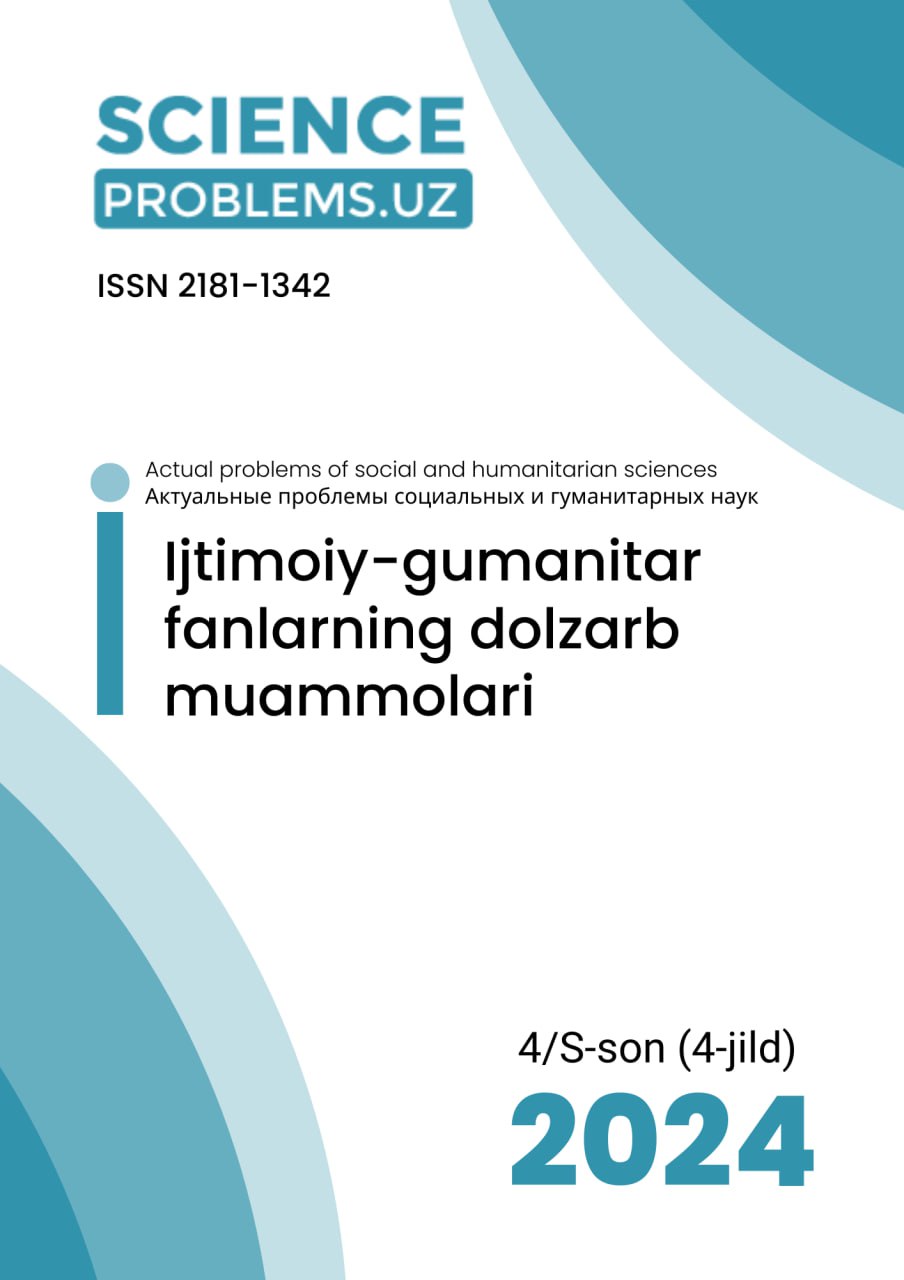INGLIZ VA O‘ZBEK NASRIDA “O‘GAY ONA” OBRAZINING BADIIY TASVIRI
Kalit so'zlar
https://doi.org/10.47390/SPR1342V4SI4Y2024N32Kalit so'zlar
ona, o‘gay ona, o‘zbek va ingliz nasri, timsollar, obraz, ijobiy va salbiy xarakter, personaj, psixik obrazAnnotasiya
Maqolada haqiqiy o‘zbek ayolining tasviri va ingliz adabiyotida tasvirlanadigan ona timsoli haqida izlanish olib borildi. Bugungi rivojlanayotgan davrda xalqimizning har bir sohada aholi savodxonligini oshirish zamonamizning eng muhim talablaridan biridir. Shuningdek, ushbu ilmiy maqolada o‘gay ona obrazining tarixiy va adabiy kontekstdagi rivojlanishi, o‘zbek va ingliz adabiyotida ushbu obrazning qabul qilinishi va evolyutsiyasi tahlil qilinadi; o‘gay ona obrazining o‘quvchilarga qanday tarbiyaviy va ijtimoiy ma’nolarni yetkazishi, uning ma'naviy xususiyatlari va jamiyatdagi o‘rnini ochib beriladi; bu obraz orqali adiblar qanday ijtimoiy muammolarni ko‘tarishi va ularni qanday yechimlarga yo‘naltirishi tahlil qilinadi; o‘gay ona obrazining psixologik xususiyatlari, uning ichki dunyosi, shaxsiy dramasi va ruhiy kechinmalari ko‘rib chiqiladi. Ingliz va o‘zbek nasrida o‘gay ona obrazining badiiy tasviri orqali har ikki millatning oilaviy qadriyatlari, ijtimoiy munosabatlari va tarbiyaviy yondashuvlari o‘ziga xos tarzda namoyon bo‘ladi. Tadqiqot natijalari adabiyotshunoslikka yangi qirralarni kiritib, o‘quvchilarning ushbu mavzuga nisbatan tushunchalarini kengaytirishga xizmat qiladi.
Manbalar
Ahmad Lutfiy Qozonchi. O‘gay ona. – T.: Yangi asr avlodi, 2018. – 392 b.
Alcantud Díaz María. Deconstructing Stereotypes Through Reading Children’s Literature as Intergenerational Play: The Case of the Stepmother. In Children’s Literature and Intergenerational Relationships: Encounters of the Playful Kind, Cham: Springer International Publishing, 2021. – P. 211-223.
Anne Ranasinghe “The stepmother” story [Internet manbaasi] https://megawp.ru/articles/62-the-stepmother-anne-ranasinghe.html
Eshmatova Y.B. Istiqlol davri oʻzbek qissachiligida ayol ruhiyatining badiiy talqini. Fil. fan. nomz...diss. – Toshkent, 2020. – 167 b.
Gray-Fow, M.J. The wicked stepmother in Roman literature and history: an evaluation. Latomus, 47 (Fasc. 4), 1988. – P. 741-757.
Hasan Manzur “O‘ga ona” nomli hikoyasi [Internet manbaasi] https://uzsmart.ru/kutubxona/asarlar/1303-%D1%9E%D0%B3%D0%B0%D0%B9-%D0%BE%D0%BD%D0%B0-%D2%B3%D0%B8%D0%BA%D0%BE%D1%8F-hasan-manzur.html
Ika M., Aditya P. Representation of Women Image in Anthology of Poetry “Poetry of Rahim” by the Women Poet of five Countries // The 1st Literature and Сulture. DOI: 10.36078/1659509920165. O‘zbekistonda xorijiy tillar, 2022, № 3 (44). – P. 155-166.
Imomov K. O‘gay qiz tipidagi turkum ertaklarning ayrim xususiyatlari. – T.: O‘zbek tili va adabiyoti. 2001, №3. – B. 78-86.
Izzat Sulton. Adabiyot nazariyasi. – Toshkent: O‘qituvchi, 2005. – 228 b.
Jalolova F.N. “O‘gay ona” konseptining lingvomadaniy talqini (ingliz va o‘zbek xalq ertaklari misolida). – Toshkent, 2023.
Joseph Jacobs. English Fairy Tales and More English Fairy Tales. – Santa Barbara, Calif.: ABC-CLIO, 2002. – 369 p.
Kaipbergenova D.O. Ingliz va o‘zbek xalq ertaklarida “stepmother/o‘gay ona” konseptining farqli jihatlari // Oriental Renaissance: Innovative, educational, natural and social sciences, (E)ISSN:2181-1784, 2023. – B. 261-266. www.oriens.uz
O‘zbek nasrida ona qiyofasining realistik tasviri [Internet manbaasi] https://hozir.org/filologiya-fakulteti-v5.html?page=11
O‘zbek xalq ertaklari. To‘plovchi: Husan Sodiqov. – Toshkent: Sharq, 2007. – 122 b.
Pencil Art Story “Kind stepmother” story [Internet manbaasi] https://steemit.com/hive-185836/@sultan-aceh/pencil-art-story-kind-stepmother
Quronov D. Adabiyotshunoslikka kirish. – T.: O‘qituvchi, 2004. – 242 b.
Raximov M. The image of women in the work of Uzbek writers // Eurosian Research Bulletin. Volume 3, 2021. – P. 11-17.
Safarov.O. O‘zbek xalq og‘zaki ijodi: pedagogika oliy o‘quv yurtlari uchun darslik. – T.: Musiqa, 2010. – 368 b.
Sattorova G.Y. Bugungi hikoyalarda ayol obrazi talqini // Scientific work (international scientific journal), 2020. No. 08/57. – P. 29–32. DOI: 10.36719/AEM/2007-2020/57/29-32
Shermurotov T. Mangu onaizor talqini. Yetuklik jozibasi. – Toshkent: Turon zamin ziyo, 2017. – 144 b.
Umarova F.B. Ingliz va oʻzbek nasrida ayol obrazining badiiy tasviri // Scientific-methodological electronic journal “Foreign Languages in Uzbekistan”, 2022, No. 3 (44). – P. 155-166. https://journal.fledu.uz ISSN: 2181-8215
Williams Christy. Who‘s wicked now? The stepmother as fairy-tale heroine. Marvels & Tales 24, no. 2, 2010. – P. 255-271.
Wittmann Gerda-Elisabeth. When love shows itself as cruelty: the role of the fairy tale stepmother in the development of the under-aged reader. Mousaion 29, no. 3, 2011.–P. 1-11.
Yozdonqulova O.Z. Ingliz va oʻzbek nasrida ayol obrazining badiiy tasviri // A cademic Research in Educational Sciences, 2023. 4(12). – B. 65–72. https://doi.org/
Виноградов В.В. О языке художественной прозы. – М.: Наука, 1980. – 360 с.
Ларин Б.А. О лирике как разновидности художественной речи. – Ленинград: Academia, 1927. – C. 42-73.
Мышкина А.Ф., Ядранская И.В. Эстетическое и этическое значение художественного произведения в образовательной среде. Развитие образования. №5(3), 2022. – P. 32-7.
Потебня А.А. Из записок по теории словесности. Фрагменты. // Слово и миф. – М., 1989. – С.249-252, 256-260.
Тимофеев Л.И. Основы теории литературы. – М., 1976. – 192 c.
Тынянов Ю.Н. Проблема стихотворного языка. – Л.: Academia, 1924. – 140 c.
Хабибуллина АН. ВОЛШЕБНАЯ СКАЗКА: ИНТЕРПРЕТАЦИЯ ВЕЧНОЙ ТЕМЫ О ЗЛОЙ МАЧЕХЕ И БЕДНОЙ ПАДЧЕРИЦЕ У БРАТЬЕВ ГРИММ И ШАРЛЯ ПЕРРО // InВызовы XXI века, 2021. – P. 94-96.








